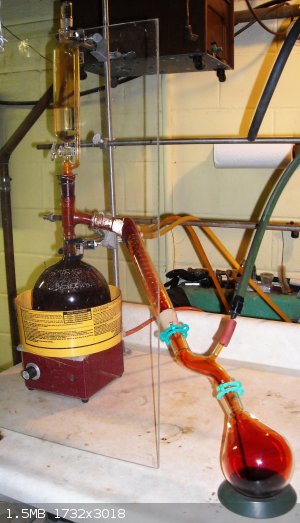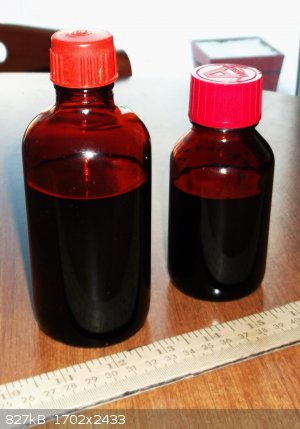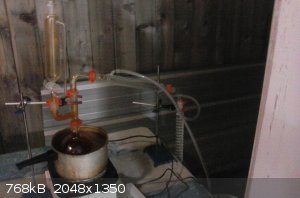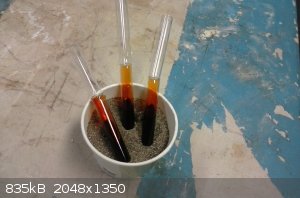| Pages:
1
..
3
4
5 |
grayson
Harmless

Posts: 2
Registered: 2-4-2017
Member Is Offline
Mood: No Mood
|
|
It sits on my table this very moment, awaiting some decision. I may continue the reaction towards completion, I may start over. I think I've got the
reaction now, I just need to reset the glassware to collect. Hopefully the slow and chilled route will do the deed and I can scratch an element off my
list.
|
|
|
Dan Vizine
National Hazard
   
Posts: 628
Registered: 4-4-2014
Location: Tonawanda, New York
Member Is Offline
Mood: High Resistance
|
|
The KMnO4 + NaBr + H2SO4 reaction seems the best way to go. The heat to drive the reaction is provided by the dropwise acid addition, no interhalogens
are produced and making a kilo of bromine at once is easy with small glassware.
 
"All Your Children Are Poor Unfortunate Victims of Lies You Believe, a Plague Upon Your Ignorance that Keeps the Youth from the Truth They
Deserve"...F. Zappa
|
|
|
symboom
International Hazard
    
Posts: 1143
Registered: 11-11-2010
Location: Wrongplanet
Member Is Offline
Mood: Doing science while it is still legal since 2010
|
|
Non chlorine shock for pools contains potassium monoperoxysulfate once added to sodium bromide bromine liquid is created. Works for iodide bromide
chloride it is strong enough to form chlorine have not tried liberating fluorine gas from fluoride that and I dont think it is not strong enrrough
oxidizer for fluorine
|
|
|
UC235
National Hazard
   
Posts: 565
Registered: 28-12-2014
Member Is Offline
Mood: No Mood
|
|
Quote: Originally posted by symboom  | | Non chlorine shock for pools contains potassium monoperoxysulfate once added to sodium bromide bromine liquid is created. Works for iodide bromide
chloride it is strong enough to form chlorine have not tried liberating fluorine gas from fluoride that and I dont think it is not strong enrrough
oxidizer for fluorine |
It is absolutely not strong enough for fluorine. Downside is how huge a mole is since it's the triple salt 2KHSO5·KHSO4·K2SO4. Pool related sources
also sometimes have NaCl added as a bulking agent (chlorine-free my ass).
|
|
|
symboom
International Hazard
    
Posts: 1143
Registered: 11-11-2010
Location: Wrongplanet
Member Is Offline
Mood: Doing science while it is still legal since 2010
|
|
What nacl as a bulking agent you are right if thats in there it immediately forms chlorine when it touches the water
|
|
|
tsathoggua1
Hazard to Others
  
Posts: 335
Registered: 8-1-2017
Location: Beyond the pale
Member Is Offline
Mood: Phosphorescent
|
|
With regards to Br2 contamination with interhalogens, I would think that this should not be a problem if preparing Br2 by bubbling Cl2 through an
aqueous solution. If bromine monochloride forms at all, it could only be as a transient species, since the interhalogens are very prone to hydrolysis.
I'm not sure about those containing fluorine, but the fluorinated interhalogens I've avoided preparing, for fairly obvious reasons. I've read what
chlorine trifluoride for example, is capable of, and it does not make for reading that is of a nature which encourages one to muck about with it.
Protective clothing and gas mask won't cut it there, given how it will, oh, set concrete ablaze for example 
Whilst I've no direct experience with bromine monochloride yet (iodine bromides are next on my interhalogen to-do list. BTW-does I2 form a tribromide
as well as a monobromide? and does BrCl3 or BrCl5 exist? are they stable, if so?) I do with iodine monochloride and have prepared a smaller quantity
of iodine trichloride.
The speed of hydrolysis is rapid, near enough instantaneous. A drop of ICl permitted to fall into cold water dissociates more or less instantaneously
into a puff of chlorine gas and the iodine with which the interhalogen was formed then falls through the water in finely dispersed form.
I should think that even if any did make it through a distillation, distilling the Br2 from H2O would efficiently remove any bromine chlorides
present.
|
|
|
woelen
Super Administrator
        
Posts: 8014
Registered: 20-8-2005
Location: Netherlands
Member Is Offline
Mood: interested
|
|
Interhalogens indeed can be hydrolyzed by water, but this reaction certainly is not instantaneous. I have quite a lot of experience with making
interhalogens and in the presence of water quite interesting things happen.
The following interhalogens can be made by the amateur chemist (forget about fluorine compounds):
- ICl (dark brown liquid, looking much like bromine, but readily solidifies to a nearly black solid, vapor is brown)
- ICl3 (orange solid in bulk form, yellow when finely dispersed, decomposes when in vapor form)
- BrCl (yellow gas)
- IBr (grey solid with pink/rose vapor)
In water, these compounds hydrolyse, but they do not decompose into their respective halogens. Your remark that a drop of ICl, falling in water, gives
a puff of Cl2 and a precipitate is false. The actual reaction is:
5 ICl + 3 H2O --> HIO3 + 5 HCl + 2 I2
In conc. hydrochloric acid you get:
3 ICl + HCl --> HICl4 + I2
No Cl2 bubbles are produced.
ICl3 reacts with water, also producing HIO3 and HCl. IBr only reacts very slowly with water, most likely poducing HIO3 and HBr and I2 and BrCl reacts
with water, giving HBrO3 and HCl and Br2, but this reaction is far from complete. In strongly acidic solutions quite a lot of BrCl can exist in
equilibrium with other species (a nice experiment, demonstrating this is to add a little KBrO3 to conc. HCl, in which you get yellow vapor of BrCl in
equlibrium with a deep yellow solution, containing BrCl, HBrO3, HCl, Cl2, and Br2).
BrCl3 and BrCl5 are not known as far as I know. The only non-fluorine binary compounds of the halogens are the four, mentioned above.
|
|
|
tsathoggua1
Hazard to Others
  
Posts: 335
Registered: 8-1-2017
Location: Beyond the pale
Member Is Offline
Mood: Phosphorescent
|
|
Thats strange, although I was going on visual examination. It certainly appeared to evolve a pale yellow-greenish gas. I took this to be Cl2 perhaps
too hastily, knowing that ICl hydrolyzes in H2O.
I was under the impression that the acid produced on reaction of ICl with HCl(g) was of the composition HICl2 not HICl4. The rxn with ICl3/H2O could
be useful, looks like a very expedient way to produce periodic acid and if desired, thence periodate salts.
How come BrCl3 does not exist? One might intuit that a hypothesis for the reason, were it ICl3 that did not exist, might be due to the large ionic
radius and atomic mass of iodine and this contributing to steric effects retarding either formation of, stability of, or both, of ICl3. But a bromine
atom is smaller than an iodine so this obviously is not the case.
Is it rather, that bromine is too electronegative to form a trichloride, whilst iodine just about comes within the range of its being possible,
especially seeing as how the interatomic bonding in interhalogens is less strong than the parent halogens as mono-elemental diatomic molecular
species . But that doesn't fit, again, with the fact that both iodine and bromine, as well as chlorine form trifluorides, although.
Interestingly, there are it seems, on looking up periodic acid in more detail, not solely the orth- and meta-periodic acids, but orthoperiodic acid
forms salts where in for example the sodium cation and presumably other group I metal cations form acid salts, orthoperiodate being of the
stoichiometry M5IO6, but there also exists a sodium hydrogen periodate where three of the cations are replaced by hydrogen, giving M2H3IO6.
Does metaperiodic acid also form acid hydrogen containing salts at all?
And, if heated past 100 'C, periodic acid can be dehydrated to the anhydride of iodic acid iodine pentoxide. I2O5 That looks like an interesting
chemical, that might be worthy of an attempt to synthesize some. I could spare the ICl since I have a bottle of the stuff sitting in the fridge
waiting for a use (the synthesis of the ICl itself was primarily a means to satisfy my thirst for knowledge and exploration, and an excuse to head to
the bench and start tinkering, to slake the urge that comes to all mad scientists when we feel the siren song calling and the red (or at least ruddy
orangey brown of bromine) mist come down
I2O5 looks interesting, since it can form hypervalent oxyions where the negative charge is on the halogen, in the form of iodyl salts (IO2+ and
iodosyl salts (IO+) with SO3 and concentrated H2SO4 respectively. anybody care to suggest experiments or syntheses which might be done with iodic
anhydride? Most iodine oxides are highly unstable, but tetraodine nonoxide is reportedly stable up to 75 'C and diiodine tetroxide is reportedly
stable up to 100 'C. Any ideas on how the tetroxide is prepared, or what might be interesting to do with it? tetraiodine nonoxide can reportedly be
prepared by treating I2 with ozone gas. What are its known properties/uses? and do interhalogens of any kind form mixed dihalogen nonoxides of the
stoichiometry XYO9 where X and Y are Cl, Br or I, respectively?
According to wikipedia these lesser known iodine oxides (it seems only the pentoxide, iodic anhydride is well known) are poorly studied. Which to me
sounds as good a reason as any to go do some studying 
And this paper https://sci-hub.ac/10.1002/jrs.1250160611 also makes mention of an iodic anhydride hydrate other than iodic acid, of the formula HI3O8. Are salts
of this acid known? what a peculiar structure.
[Edited on 14-6-2017 by tsathoggua1]
|
|
|
JJay
International Hazard
    
Posts: 3440
Registered: 15-10-2015
Member Is Offline
|
|
If I had copious quantities of permanganate salts, I would use them for preparing bromine, but I have less than 500 grams of potassium permanganate on
hand, and it's not cheap. Concentrated hydrogen peroxide is not available everywhere, but I can easily purchase it from garden stores. It's also very
convenient to use a bromate salt, which can be prepared from a bromide salt.
[Edited on 15-6-2017 by JJay]
 
|
|
|
carbon85
Harmless

Posts: 11
Registered: 28-3-2018
Member Is Offline
Mood: No Mood
|
|
hi guys just doing some research and come across this great thread . I am in need of some bromine between 50 - 100ml looking to prepare this outside
with limited glassware / apparatus no distillation accessible . Could someone shoot me down some tips and the quantity's of the reagents used please
cheers guys
|
|
|
woelen
Super Administrator
        
Posts: 8014
Registered: 20-8-2005
Location: Netherlands
Member Is Offline
Mood: interested
|
|
Hmmm, 50 - 100 ml of bromine is a lot! It is a dense and also quite toxic chemical, which is very hard to contain. The only really satisfactory way of
storing it is in glass ampoules. It also can be stored in bottles with thick teflon liners in their cap (e.g. Schott-Duran bottles with the nice red
GL45 or GL32 caps, holding a sturdy PTFE liner). But even in that kind of bottles, over the months, you get slight leakage and deterioration of the
cap. You need to replace that cap every two years or so, or use up the bromine.
If you have no distillation setup, then the only option is to make the bromine from a highly concentrated solution of bromide and bromate at a 5 : 1
molar ratio (assure slight excess of bromate) to which 40% or so sulfuric acid or pH-minus (swimming pool chemical, NaHSO4) is added in excess amount.
With a pipette you then can separate the bromine from the aquaous layer.
Working up the bromine must be done outside on a breezy day!! Do not mess with larger amounts of bromine inside if you value your life.
|
|
|
carbon85
Harmless

Posts: 11
Registered: 28-3-2018
Member Is Offline
Mood: No Mood
|
|
Hello
Thanks for the advice
I do not intend to store for long periods of time in my first post i stated that i wanted between 50ml to 100ml maybe that's a bit excessive for now
ad least without to correct equipment ie distillation
So i will try to produce around 20ml of bromine using a concentrated solution of sodium bromide with sodium bromate
5 parts of sodium bromide to 1 part sodium bromate ? and i am adding the acid until no more bromine drops to the bottom ?
|
|
|
woelen
Super Administrator
        
Posts: 8014
Registered: 20-8-2005
Location: Netherlands
Member Is Offline
Mood: interested
|
|
It is a very simple procedure. Prepare a saturated solution of NaBr, add the solid NaBrO3, slight excess amount, relative to NaBr, and then add a
calculated amount of 40% sulphuric acid (take excess amount, appr. 1.5 times calculated stoichiometric amount). You need to swirl to dissolve all the
NaBrO3.
|
|
|
| Pages:
1
..
3
4
5 |